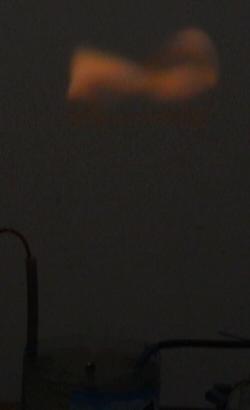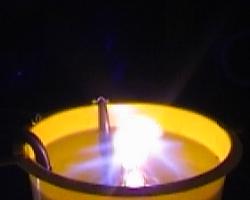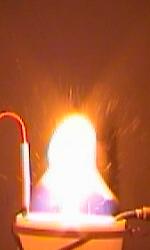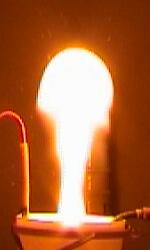| Home | Conception | Experiments | Our Publications | Related Phenomena | Ball Lightning Library | Links |
 |
 |
![]()
Overview General view and different stages of the discharge Initial stage - "spider" Formation of plasma column and/or mushroom-shaped object Formation of an autonomous object (LLPF-WD) Relaxation stage Autonomous objects Almost spherical objects Objects of oval and irregular forms Objects with envelopes Polychromic objects Evidences of energy storing - experiments on interaction of the objects with cotton wool and metal wires Spectral observations Some effects - guiding, branching, and splitting of the objects
![]()
Our colleagues G.D.Shabanov, A.I.Egorov and S.I.Stepanov from Petersburg Nuclear Physics Institute (PNPI), Gatchina, discovered and investigate a new type of high-voltage axial-symmetric erosional discharge between underwater ring-shaped anode made from a wire and a rod cathode, isolated from the water by a quartz tube. In this discharge, further referred to as high voltage erosional water discharge (HVEWD), long-living autonomous plasma formations (LLPF-WD) appear, which resemble the ball lightning in some of their properties [1,2]. These objects usually have the form of a round luminescent volume 10-20 cm in size with sufficiently sharp top and lateral edges; they float up from the water surface like a bubble. During the lifetime, which is about 0.3-0.5 s, their radiation intensity decreases monotonically from dazzle to barely visible, and the round shape disappears gradually.
Despite significant difference of parameters of the ball lightning and of the LLPF-WD, this discharge is very interesting and important both for understanding of the properties of the natural objects and for acquisition of the strong resemblance in experimental modelling of the latter. This is due to a good combination of the installation design and of parameters of the discharge and of the generated plasma formation, convenient for carrying out of measurements and observations.
In our laboratory at Saint-Petersburg State University (SPbGU), we reproduced the results of our colleagues from PNPI and carried out further researches, which allowed modify the discharge technique and obtain LLPF with practically perfect spherical form at initial stage of the relaxation. These objects have an envelope looking like a thin elastic film, separated from its gas-like contents by a gap of few millimeters in length. The envelope arises, probably, from cathode erosional jet particles, enclosed by oxides, which reach most easily the upper part of the plasma volume. It then flow down, gathering in folds or rolls. For more details, see our joint article [3] (now only in russian, Word97 document, ~700Kb).
References
Click here for several images
and AVIs of LLPF-WDs obtained by our colleagues from PNPI, Gatchina
![]()
The following 5 images from videorecording of an HVEWD
experiment show characteristic stages of the LLPF-WD formation and evolution
(here you can see full sequence of 10 frames
at a higher resolution).
 |
 |
 |
 |
 |
|
|
|
|
|
|
1. Initial stage of the discharge - "spider".
After the initiating breakdown several discharge channels
developed from cathode over the water solution surface, which then filled
up by erosional plasma from the solution surface during about ~10ms. Above
the cathode a more bright dome-shaped volume appeared which the cathode
erosional plasma entered in.
Another 4 images of "spiders" are given below.
 |
 |
 |
 |
2. Formation of plasma column and/or mushroom-shaped object.
During this stage the dome-shaped
plasma volume increases in size both in the radial and vertical directions
and and turns into a plasma column, its height atteining 25-30 cm
and more. The upper part of this column slows down and enlarges, turning
into a cap, so that the wholel plasma volume takes the shape of a mushroom.
 |
 |
 |
 |
|
|
|
|
|
 |
 |
 |
 |
|
|
|
|
|
Following 4 images show some mushroom-shaped objects obtained in our experiments.
(Envelopes, distinctly visible on the last 2 images, will be discussed below.)
In some cases the lower part of the plasma column has a semitransparent blue veil.
3. Formation of an autonomous object
At this stage the luminescence of the lower and middle parts (stem) of the mushroom object practically disappears, while the cap change into a plasmoid of spherical, truncated sperical, oval
or irregular shape (LLPF-WD - long-living plasma formation from water discharge). 2 images of practically spherical objects are presented at the top of this page, the following objects are of a less perfect shape:
LLPF-WD seem to be autonomous, i.e. disconnected from the discharge, but at high concentrations of the water solution it is not really so, as shown by simultaneous observation of LLPF-WD and a protection spark gap connected in series with the main discharger (in the lower left coner on the images below; click on images to see them at higher resolution).
Use of the new technique, described in [3], gives the possibility to obtain objects with an envelope looking like a thin elastic film, separated from its gas-like contents by a gap, atteining several millimeters in length. Envelopes can be of sufficiently intricate shape, for example they can gather in folds or rolls. They consist, probably, of oxidated metal particles from the cathode erosional jet.
Other available LLPF-WD images, due to their great number, are presented on the following separate pages:
Almost spherical objects Objects of oval and irregular forms Objects with envelopes Polychromic objects After disconnecting from the discharge, the luminosity of the LLPF-WD decreases gradually and its shape becomes less regular. After ~150-200 ms the object turns into a reddish-brown toroidal plasma vortex, and then into a smoke vortex.
The following image sequences show 3 experiments with torus formation:
Seq.1 Seq.2 Seq.3
![]()
| Home | Conception | Experiments | Our Publications | Related Phenomena | Ball Lightning Library | Links |